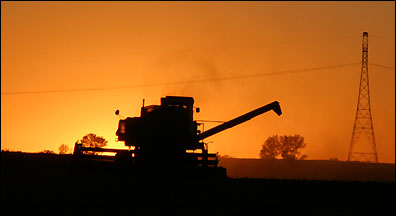Weather "miracle" extends season, saves crops
 Thanks to the warm weather in September, crops had extra growing time to make up for lost growth during cool, wet weather this summer.
Thanks to the warm weather in September, crops had extra growing time to make up for lost growth during cool, wet weather this summer.
For the past couple of weeks, area farmers have enjoyed beautiful, sunny weather while chopping corn for silage and harvesting soybeans.
Dallas Fenske combined soybeans in a field west of Paynesville last week as the sun set behind him. Farmers have reported average yields so far this fall, but even those yields were possible only with a warm September that extended the growing season, though it delayed harvesting.
And while farmers may be a little disappointed in their soybean yields, Dave Schwartz of the Kandiyohi County Extension Office believes the September weather was nothing short of a miracle. Without the wonderful weather, farmers would have faced a dismal harvest season with very low yields, he said.
"It's not as good as I expected," said Dallas Fenske, who farms west of Paynesville, but he knows it could have been a lot worse.
Crops got off to a slow start when a drought threatened central Minnesota in early spring, causing plants to germinate more slowly than usual. Then, the weather turned unusually cool and wet for most of the summer, and an August frost caused sporadic damage in low-lying corn and soybean fields throughout the area.
Fenske has seen average soybean yields on his irrigated crops and lower yields for crops on dry land. Some tops of his low-lying crops were frozen in August when the night temperatures dropped below 28 degrees, and those plants didn't fully recover, he said.
Without a warm September, his yields would have been a lot lower, though. "I'm just thankful we had the weather we did,"said Fenske.
Ray Loxtercamp, of the Regal Elevator, agrees that the soybean harvest looks better than it would have if September hadn't been warm. With the potential for really low yields, most of the farmers he has talked to have reported average yields - about 30 to 40 bushels per acre - of soybeans.
With temperatures in the 70s and 80s extending the growing season through September, this year's harvest is at least two weeks behind normal. "I'm just glad to get at it," said Fenske, of harvesting.
Farmers who grow corn for silage, whole corn stalks chopped for use as feed, have been pleasantly surprised by their yields and by the quality of their silage.
Pete Hopfer, who farms with his family near Lake Henry, was shocked to find his silage corn was as tall as his tractor cab. "I don't think we've ever had constant nine-to ten-foot silage corn," he said.
Hopfer believes the family will have more silage than they can store. If that happens, they will wait and combine some of the corn that was intended for silage.
Farmers have been furiously chopping silage night and day since the killing frost last week, according to Dan Martens of the Stearns County Extension Office.
The weather has been a mixed blessing to farmers chopping silage, Martens said. On the one hand, the warm September gave the corn a much-needed boost, but now the corn is drying too quickly to use for feed, he said. Farmers need to get that corn out of the fields now or it will not ferment properly and will mold in storage. If this happens, the silage won't be as nutritious and the cows won't like it.
Adding liquid whey to silage that is too dry will help, said Schwartz, but doing so can be time-consuming and costly.
Soybeans and corn for combining are both drying nicely, added Schwartz, reducing or eliminating the need for drying after harvest. With propane prices high, the money that farmers don't spend drying crops can help offset income lost on reduced yields.
The area's corn harvest hasn't begun yet, but Schwartz believes that corn yields should be about average.
According to Hopfer, corn for combining in his area looks pretty good with large ears on most stalks.
Fenske agreed, thanking the warm September for what he believes will be a good corn crop. "A month ago, we thought the corn was pretty sick," he said.
"The outlook is so much brighter than a month ago," said Schwartz.
Contact the author at editor@paynesvillepress.com • Return to News Menu
Home | Marketplace | Community